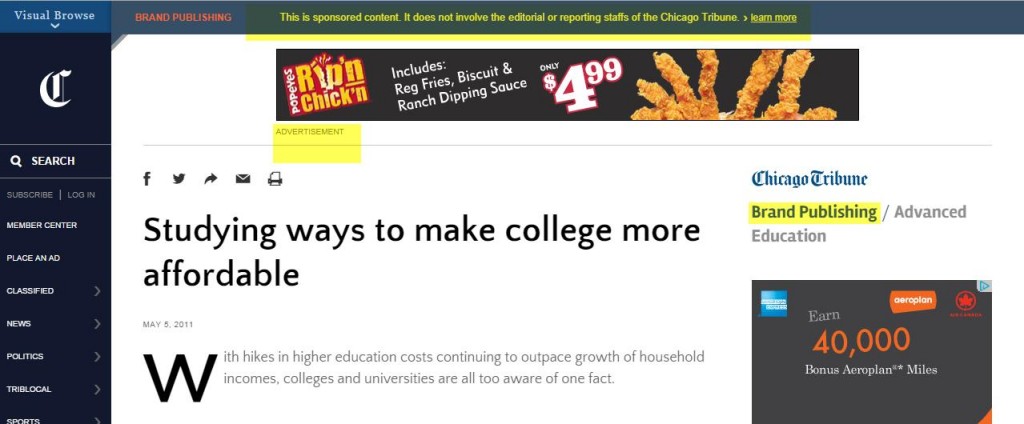College and university marketers are working hard to master content marketing and reap the benefits of increased visitor traffic, increased engagement and increased SEO rankings. At the same time, content marketing continues to evolve, providing new challenges and opportunities with respect to how to best market your institution. Regardless of whether you see more of its detractors or its opportunities, native advertising will play an increasingly important role in your digital marketing world in the near term.
Wikipedia defines native advertising as :
” Native advertising is an advertising method in which the advertisers attempt
to gain attention by providing content in the context of the user’s experience.
Native ad formats match both the form and function of the user experience
in which they are placed. The advertiser’s intent is to make the paid advertising
feel less intrusive and thus increase the likelihood users will click on it. “
At its simplest, native advertising can take the form of a promoted tweet or a LinkedIn sponsored post within a users content or news feed. They are usually identified by an indication that it is a sponsored post, as seen below. The degree to which different platforms highlight its sponsored content varies widely. A native ad’s format is typically unique to its platform and quite customized to blend into it. Here is an example from my LinkedIn page. (Note, the yellow highlighting is mine, and does not appear in LinkedIn’s newsfeed.) This post links to a lead generation landing page on Walden University’s website.

Sponsored content and branded content are longer form, more complex types of native content. Sponsored online video ads are one very popular form of this type that are used extensively in Business to Consumer marketing. GoPro and Redbull are the masters of this genre of advertising but I am sure it won’t be long before some of our more creative counterparts out there begin to experiment with it in higher ed. (If you can send us examples please let me know. I will add them to this post’s comments section. )
In the case of sponsored articles, a publisher will create custom content and a brand, as in the college advertiser, will pay to have their name linked with that story. In the cases below, note the clear identification with the advertisers, which usually indicates the articles have been sponsored by them.
In the case of branded content, as in the Chicago Tribune example below, the college advertiser creates the content for the publisher and pays the publisher to publish it. As is clearly indicated in the header bar, the publisher is not involved in any way in reporting, authoring or editing the content. In this example, four private universities from the greater Chicago area are mentioned in the article, so we can assume they are the sponsoring client.
So why should you care about the role of native advertising in the higher ed marketplace? Here are 3 good reasons:
- Native advertising works better than banner advertising. Research indicates that native gets 15-45 times higher click-throughs, 18 times more time spent on content, 10 times more engagement and 50% higher purchase intent. These are pretty significant increases on advertising ROI which could have a significant impact on your overall marketing performance.
- Native advertising options are exploding dramatically. Native advertising is expected to grow from a $1.6 billion market in 2012 to $4.6 billion by 2017, according to research firm BIA/Kelsey.
- Native advertising has serious ethical dimensions. Contently published the results of a survey that found 66 percent of consumers have felt “deceived” when they realized an article or video was brand-sponsored. And more than 50 percent said they don’t trust sponsored content! As you can see in the earlier examples, a wide swatch of higher ed marketing is already moving into native advertising. You need to determine your position on it.
Have you already adopted the use of native advertising? So where is your line in the sand with respect to the ethics of native advertising? Has your marketing department formulated its position yet? Have you received any negative feedback from students about your native campaigns?

Please share your thoughts on native advertising with us in our comments. We look forward to hearing from you.








